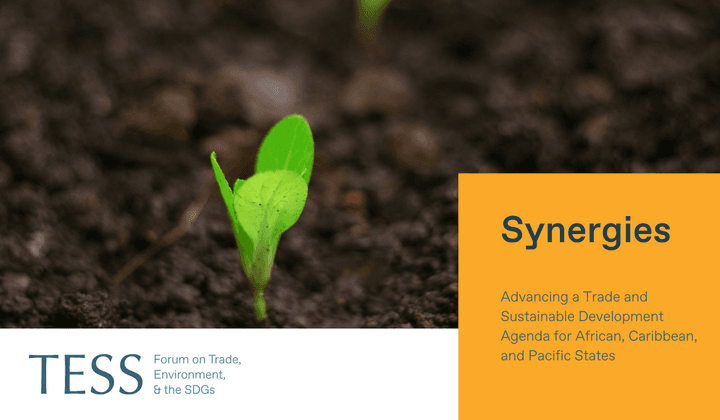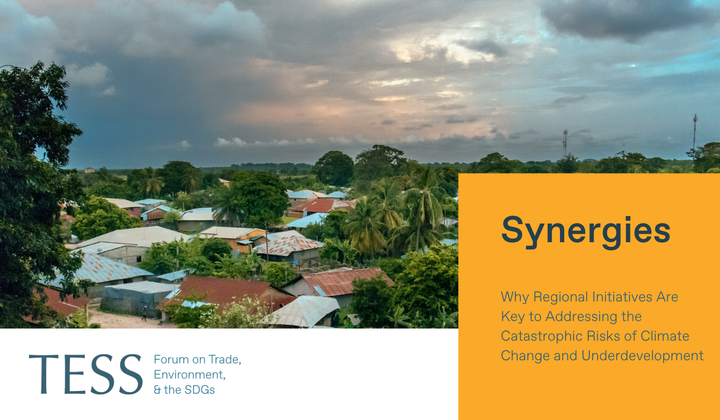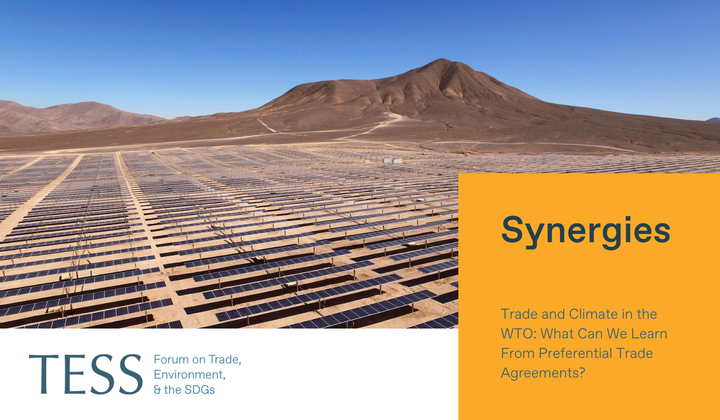Establishing a green trade arrangement—involving reductions in tariffs and non-tariff barriers on a carefully selected list of environmentally beneficial goods and services—could aid in combatting climate change and bolster economic growth. But implementation on a global scale may prove challenging. Utilizing existing regional trade agreements, such as the Regional Comprehensive Economic Partnership in the Asia Pacific, could demonstrate the economic benefit to all member states, encourage green foreign direct investment, and promote a more inclusive approach to a “just” climate transition.
This article is part of a Synergies series on climate and trade curated by TESS titled Addressing the Climate Crisis and Supporting Climate-Resilient Development: Where Can the Trading System Contribute? Any views and opinions expressed are those of the author(s) and do not necessarily reflect those of TESS or any of its partner organizations or funders.
-----

US President Donald Trump’s decision to raise tariffs on imports from Canada, China, and Mexico, and all imports of aluminium and steel, has led the world to brace for major trade disruptions and economic confusion. Protectionism has come back into vogue and countries are cultivating critical sectors at home to bolster their economic security.
The retreat from free trade will accelerate under Trump, with far-reaching consequences—especially in the fight against climate change.
But the world has changed significantly in recent years. A deeper trend visible beyond the posturing and threats includes growing recognition of the urgency of cultivating homegrown green industries to combat climate change. This climate imperative must serve two mutually reinforcing goals—staving off further temperature increases and boosting economic growth and job creation.
Green trade is international trade in green goods and services in areas such as renewable energy, green transportation, energy efficiency, waste management, sustainable agriculture, nature-based solutions, and environmental professional services. Allowing free green trade—the trading of green goods, services, and technologies as freely as possible across nations—will help decarbonize the economy and protect the environment at low cost.
A green trade arrangement would involve reductions in tariffs and non-tariff barriers on a carefully selected list of green goods and services that deliver environmental and climate benefits. This will reduce the costs of green goods and services in most countries, boost green industries, and enable faster and wider adoption of low-carbon practices and technologies.
Introducing green trade policy on a global scale is challenging as one or two nations can obstruct a complex global deal. But it can be built on the foundations of existing regional trade agreements, among a smaller “coalition of the willing.” In the Asia Pacific region, the Regional Comprehensive Economic Partnership (RCEP) offers one avenue for freeing up green trade. As the world’s largest trading bloc, by population and GDP, it comprises 15 countries and accounts for 30% of global economic activity.
A green trade arrangement could operate within the terms of RCEP, eliminating tariffs and significantly reducing non-tariff barriers on green goods and services ahead of the bloc’s existing eight-year timeline for full tariff removal.
Designing the list of green goods and services that should be covered by the green trade arrangement is the first step that is needed. An initial study by the Institute of Finance and Sustainability (IFS) suggests that this list could include a few dozen categories and a few hundred products and services.
Demonstrating the economic benefits of a green trade agreement to all member states will be key. Robust design of the arrangement must ensure that all member countries in the bloc benefit economically, accelerating their pace of decarbonization and advancing the growth of their green industries.
Incentives for green foreign direct investment and technology transfers—such as a more stable policy environment, enhanced protection for investors and intellectual property rights—need to be incorporated into the green trade arrangement to increase trade and encourage cross-border green investment and technology transfers and help low-income countries develop green industries and jobs.
If RCEP adopts the idea, a larger number of Chinese, Japanese, and South Korean electric vehicle and renewable energy equipment manufacturers are likely to invest in supply chain development and license technologies to local producers across ASEAN countries.
There needs to be a balance between the need for policy incentives to stimulate green industries and trade-distorting subsidies. Government incentives for the production and consumption of green goods and services are often viewed favourably, but they can lead to trade disputes. Within the RCEP framework, it would be helpful if some no-significant-harm principles and prohibited subsidies could be agreed upon.
Non-tariff barriers not only tariffs must be removed or reduced. Under many free trade arrangements, non-tariff barriers are often more significant impediments than tariffs to international trade and investment in green industries. This requires a serious stocktake of all non-tariff barriers, including import and export quotas, quality inspection against domestic standards, customs clearance processes, product traceability requirements, trade finance and export credit insurance, and cross-border payment and settlement. Options should be developed to reduce these barriers, including harmonizing green product and traceability standards and reducing the cost of trade finance using green finance instruments.
A dialogue that considers all these factors will be crucial and larger economies such as China, Indonesia, Australia, Japan, and South Korea can play a key role in forming an initial consensus on the economic and climate merit of a green trade initiative within RCEP.
A regional green trade arrangement can be an inclusive approach to support a “just” climate transition. It will promote decarbonization and mutual economic benefits in all member states—via job creation and revenue growth. A multilateral approach will build mutual trust for broader cooperation on climate and trade issues.
The case for green trade arrangements is even stronger compared to the approach being embraced by some advanced economies. While the Carbon Border Adjustment Mechanism (CBAM) favoured by the European Union can reduce carbon leakage from imports, it harms incomes and employment in developing economies exporting carbon-intensive goods. Such unilateral measures are likely to lead to retaliation and yet more protectionism.
CBAM amounts to a “stick” that punishes developing countries for not sacrificing domestic growth and development to reduce emissions. In contrast, a green free trade arrangement provides a “carrot” encouraging green production and trade. Aligning climate goals with trade and development objectives rewards all participating economies for making progress on the green transition with mutual gains from trade, an initiative of the type a just green transition demands.
* This article was first published in the East Asia Forum.
----------
Ma Jun is the Founder and President of the Beijing-based Institute of Finance and Sustainability, and former co-chair of G20 Sustainable Finance Working Group.
-----
Synergies by TESS is a blog dedicated to promoting inclusive policy dialogue at the intersection of trade, environment, and sustainable development, drawing on perspectives from a range of experts from around the globe. The editor is Fabrice Lehmann.
Disclaimer
Any views and opinions expressed on Synergies are those of the author(s) and do not necessarily reflect those of TESS or any of its partner organizations or funders.
License
All of the content on Synergies is licensed under a Creative Commons Attribution-NonCommercial-ShareAlike 4.0 International (CC BY-NC-SA 4.0)
license. This means you are welcome to adapt, copy, and share it on your
platforms with attribution to the source and author(s), but not for
commercial purposes. You must also share it under the same CC BY-NC-SA
4.0 license.
If you would like to reuse any material published here or if you have any other question related to Synergies, send an email to fabrice.lehmann@graduateinstitute.ch.




